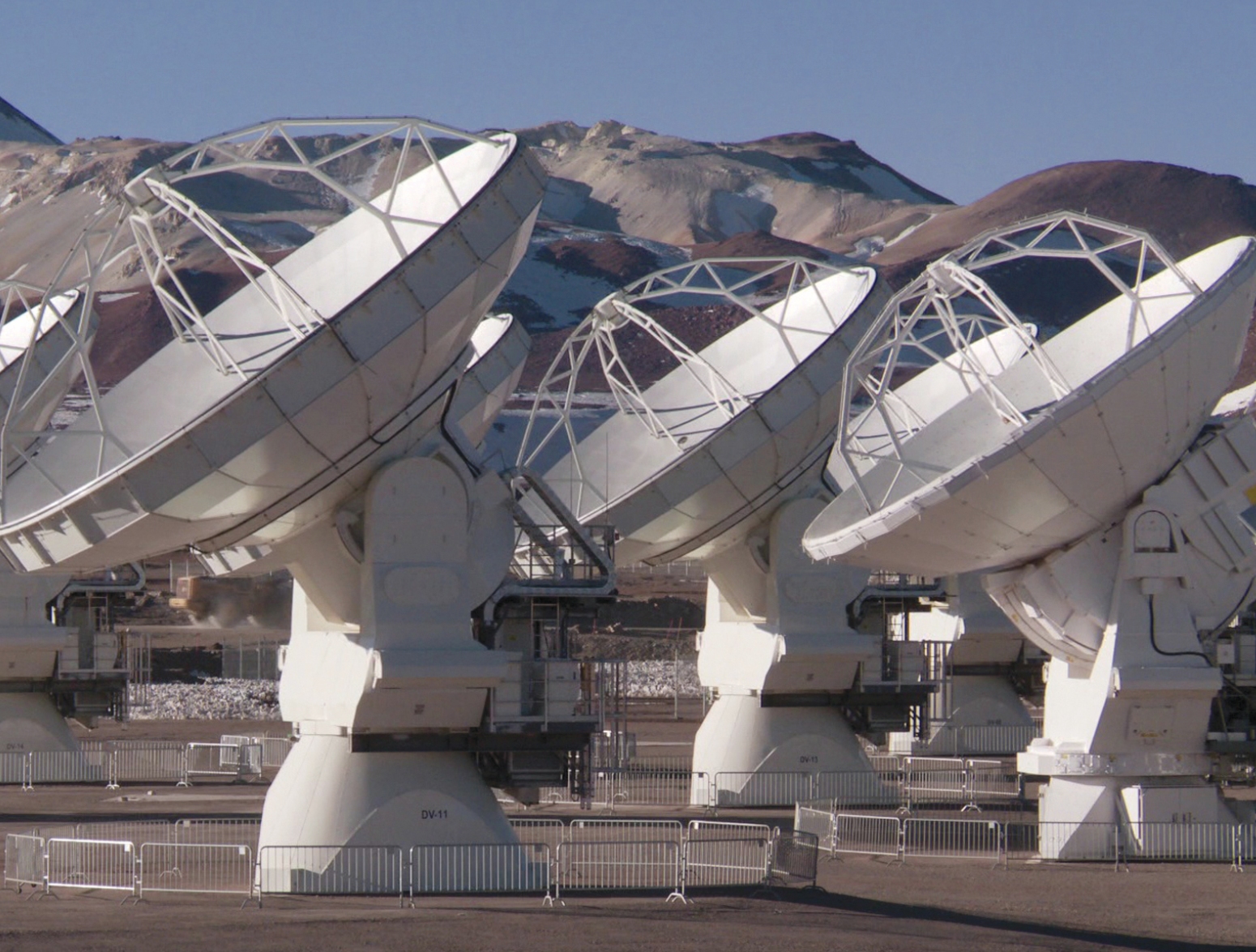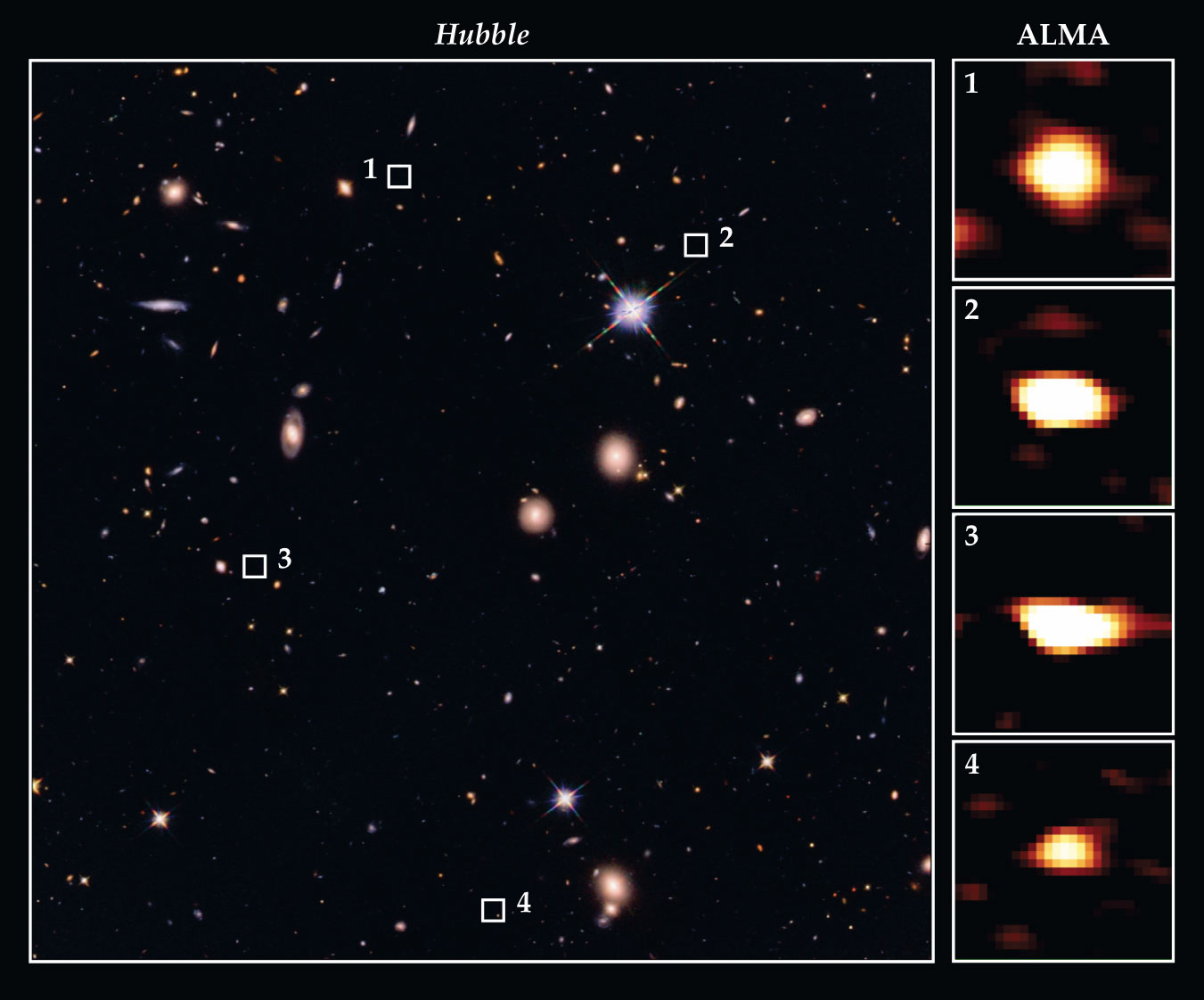Massive galaxies from the early universe found hiding in plain sight
DOI: 10.1063/PT.3.4312
Opened in 2012, the Atacama Large Millimeter/Submillimeter Array (ALMA), shown in figure
Figure 1.

Antennas from the Atacama Large Millimeter/Submillimeter Array are on an elevated desert plateau ideal for measuring wavelengths from the far-IR to radio. The 66 antennas can cluster together for higher-sensitivity measurements or spread over tens of kilometers to zoom in on details. (Courtesy of W. Garnier/ALMA/ ESO/NAOJ/NRAO.)

Now Tao Wang of the University of Tokyo and his colleagues have used ALMA to find a missing link in the story of galaxy formation. 1 Before he and his team made their discovery, the low number of massive galaxies, with masses above 1010 solar masses, observed from the first 2 billion years after the Big Bang could not account for the significantly higher number observed from the next billion years. ALMA’s wavelength range is perfect for finding those ancient massive galaxies not visible in previous measurements, and Wang and his team did just that.
Redshift your perspective
Because the universe is expanding, emitted radiation from galaxies redshifts to longer wavelengths the farther away it starts from Earth. A wave’s journey to us takes time, so to observe a redshifted wave is to look into the past. Redshifts are determined by identifying an emission line in a galaxy’s spectrum and measuring how far its peak wavelength, λobs, has shifted from its rest-frame value, λ0. Redshift z is defined as (λobs − λ0)/λ0. Although spectral features broaden in their long journey across the universe, the redshift is still identifiable. Radiation with z = 3 was emitted when the universe was 2 billion years old.
In its rest frame, a galaxy’s visible-to-UV emission spectrum drops off suddenly for wavelengths shorter than 912 Å. Light with shorter wavelengths than that limit ionizes hydrogen gas in and around the galaxy before it escapes. As the radiation gets redshifted, the sudden break in the spectrum shifts to higher wavelengths—even into the UV range measurable from Earth. Astronomers identify high-redshift galaxies, with z > 3, by filtering the emission and comparing its higher signal in the visible range with its much lower signal in the UV. Galaxies discovered using that method are known as Lyman-break galaxies (LBGs).
Previous measurements performed with the Hubble Space Telescope and at Las Campanas Observatory in Chile found many massive galaxies with redshifts z of 2–3, which existed 2 to 3 billion years after the Big Bang. 2 But far fewer have been found from earlier stages in the universe’s evolution, with z > 3. Those found thus far either are LBGs with much smaller stellar populations than later galaxies or are extreme starburst galaxies, which have high star-formation rates and are brighter than a typical massive galaxy. Together they are too small or too few to have made all the galaxies seen with a z of 2–3.
The Lyman-break selection method overlooks some galaxies. For the break to appear precipitous and therefore be identifiable in Earth-based visible and UV images, a galaxy must emit enough at wavelengths just above the Lyman break. That condition is unlikely to be met by massive galaxies because the surrounding dust dims the outgoing emission or because their stars are older and emit less right above the break to begin with. Detectors that have higher sensitivity and are able to measure into the mid- and far-IR provide a higher signal to compare with UV images. But the exact wavelength ranges one compares are important. Galaxies at lower redshifts can mimic those with higher redshifts if their spectrum is pushed to a redder color by attenuation from high levels of dust or is intrinsically redder because it comes from an active galactic nucleus rather than stars.
Hiding in plain sight
A few years ago, Wang and his team hunted for those missing massive galaxies in the mid-IR. 3 They found a specific combination of filters capable both of finding galaxies too faint for Lyman-break selection and of distinguishing between older galaxies and younger mimics. Using the Spitzer Space Telescope’s Infrared Array Camera, they captured an image at 4.5 µm, which they subtracted from existing Hubble Space Telescope measurements in the near-IR. A difference in the intensity above a certain threshold indicated the location of a potential galaxy in the distant universe. Through that method, Wang and company identified 63 potential ancient massive galaxies not found using Hubble’s measurements alone.
But the galaxies are still very faint at 4.5 µm, and measurements with better spatial resolution and at multiple wavelengths would reveal more about their properties. The researchers knew they needed a facility such as ALMA, with detection in the far-IR. Taken in the summer of 2016, their ALMA images resolved the galaxies and confirmed that 39 of the previously identified objects are star-forming massive galaxies invisible in the Hubble images: Four are shown in figure
Figure 2.

Ancient massive galaxies visible with the Atacama Large Millimeter/Submillimeter Array (right) in the far-IR are invisible to the Hubble Space Telescope (left). (Courtesy of Tao Wang.)

Once older massive galaxies are identified, there’s still the question of figuring out their exact redshift. It’s much harder to measure a full spectrum, so many observatories stick with radiation that is detected through a broad filter and not spectrally resolved. Such a measurement gives just one number—the intensity—rather than the individual spectral lines necessary to calculate the redshift. Instead, the data need to be fitted with an expected spectral energy distribution to find what is called the photometric redshift, which has a larger uncertainty than redshifts found from spectroscopy.
Corentin Schreiber of Oxford University in the UK was in charge of figuring out the redshift in the team’s ALMA measurements—a tricky task because most photometric methods use measurements in the UV to visible rather than in the far-IR. By combining different photometric methods and cross-correlation with galaxies known to be of the same age, Schreiber found that the median redshift was z = 4, corresponding to radiation emitted about 1.5 billion years after the Big Bang.
The galaxies are faint, below the detection limit of a single antenna, and massive, with most in the range from 1010 to 1011 solar masses, an order of magnitude larger than the average LBG. The shape of their spectral energy distribution indicates the rate at which they produce stars, and on average they churn out 200 solar masses’ worth of stars per year—that’s about 10% of the rate previously found for LBGs and starburst galaxies of the same age but one to two orders of magnitude higher than LBGs of similar masses. Their star-formation rate coupled with their densities of 2 × 10−5 galaxies per cubic megaparsec, two orders of magnitude higher than starbursts’, mean the new galaxies are responsible for the majority of the stars produced by massive galaxies in the early universe.
The problem for theorists
Although the newly found ancient galaxies help explain the presence experimentally of so many, and such large, massive galaxies at lower redshifts, they present a problem for most galaxy-formation theories (see the article by Jeremiah Ostriker and Thorsten Naab, Physics Today, August 2012, page 43
“More and more observations show that a large population of massive galaxies and supermassive black holes has already been established in the young universe,” says Wang. “In general, the young universe is more efficient in forming big things than we thought.” To reconcile theory with observations, astronomers will need more accurate redshift measurements and better characterization of the physical properties for a larger sample of galaxies so they can put more stringent constraints on galaxy-formation models.
References
1. T. Wang et al., Nature 572, 211 (2019). https://doi.org/10.1038/s41586-019-1452-4
2. C. Schreiber et al., Astron. Astrophys. 618, A85 (2018). https://doi.org/10.1051/0004-6361/201833070
3. T. Wang et al., Astrophys. J. 816, 84 (2016). https://doi.org/10.3847/0004-637X/816/2/84
